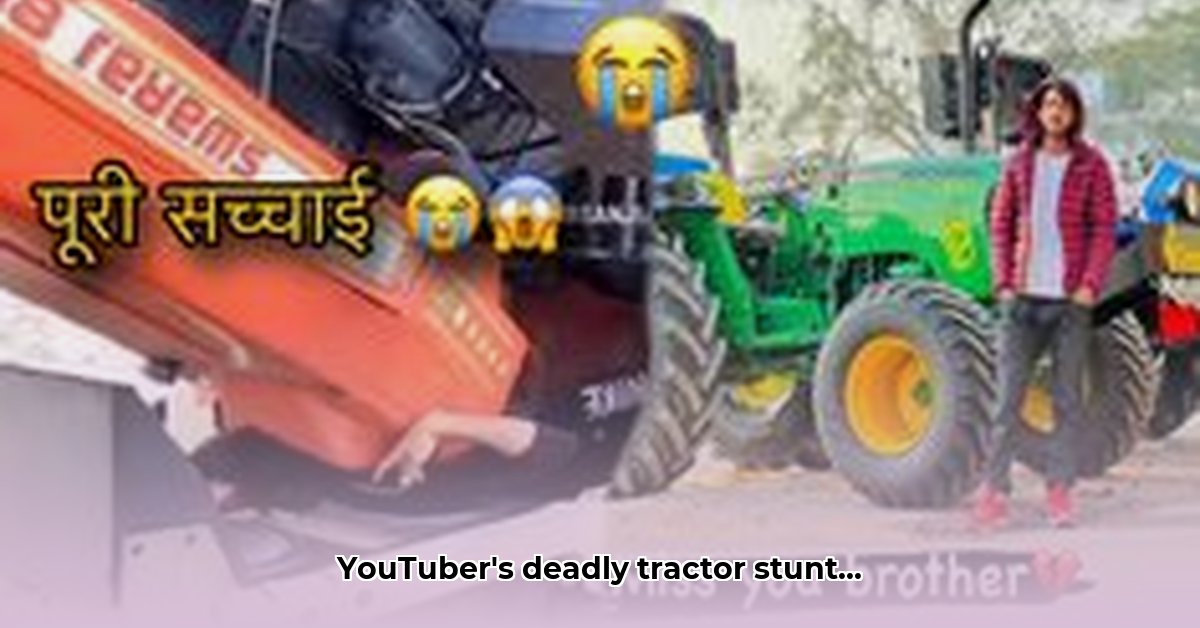
A Tragic Accident and the Urgent Need for Change
The death of Indian YouTuber Nishu Deshwal during a tractor stunt has sent shockwaves through the online community and ignited a critical conversation about online safety and responsibility. Deshwal, known for his videos featuring agricultural machinery, tragically died when his tractor overturned during a wheelie—a stunt he had performed numerous times before. The simplicity of the stunt belies the gravity of the outcome, highlighting the inherent dangers of online entertainment and raising critical questions about the responsibilities of creators, platforms, and viewers alike. This isn't simply a sad story; it's a wake-up call.
The Day the Stunt Went Wrong
Details surrounding the accident remain under investigation, but initial reports indicate that Deshwal's tractor overturned during a wheelie maneuver. While he'd previously executed this stunt successfully, this time the maneuver proved fatal. The investigation will focus on several key areas:
Mechanical Failure: Investigators will assess the tractor's maintenance history, looking for any mechanical defects or inadequate maintenance that might have contributed to the accident. This includes examining the structural integrity of the tractor, as well as any safety features, such as the Rollover Protective Structure (ROPS).
Operator Error: While Deshwal was experienced, the investigation will determine if operator error contributed to the accident. Factors such as skill level, weather conditions, and terrain will be assessed. The possibility of exceeding the tractor's capabilities during the stunt will also be explored.
Environmental Factors: The impact of environmental factors, such as terrain variations, weather conditions, or any unforeseen obstacles, will be considered. Were there any extraneous circumstances that could have increased the risk?
Unraveling the Mystery: Expert Perspectives
The complexity of determining the exact cause of the accident necessitates expert input. “The investigation is a meticulous process,” explains Dr. Anya Sharma, a mechanical engineer specializing in agricultural machinery safety at the Indian Institute of Technology Delhi. "We're examining every aspect, from the tractor's design and maintenance to the operator's skill and the environmental conditions during the stunt." This detailed analysis, she assures, will aid in forming concrete recommendations to improve future safety protocols.
Dr. Rohit Kumar, a social media analyst at the National Institute of Public Policy, commented on the broader implications: “Deshwal’s death isn't solely an accident; it’s a symptom of a wider issue—the pressure to create increasingly daring content to attract views and engagement. This pressure can incentivize risk-taking that’s disproportionate to the rewards.”
The Social Media Shadow: Fame, Risk, and Responsibility
Deshwal's death illuminates the complex interplay between online fame, risk-taking, and responsibility. The pressure to create viral content can override rational decision-making. How can platforms better mitigate these risks? Should there be stricter regulations regarding online stunts involving potentially hazardous machinery? These are crucial discussions that must be held considering the countless others who seek online fame through risky feats.
The online response to Deshwal’s death has been a mixture of grief and a critical examination of the risks associated with online stunts. The tragedy serves as a stark reminder of the potential consequences of prioritizing views over safety.
Preventing Future Tragedies: A Multifaceted Approach
This tragedy underscores the urgent need for a comprehensive approach to prevent similar incidents:
Enhanced Safety Protocols: Implementing stricter safety guidelines for online stunts, including mandatory safety training, pre-stunt equipment inspections by certified mechanics, and risk assessments. The efficacy of these measures could drastically reduce the likelihood of future incidents.
Platform Responsibility: Social media platforms must enhance content moderation and implement stricter policies against videos promoting dangerous behavior. Promoting educational resources on safe practices and responsible content creation is paramount.
Community Support: Establishing supportive resources for online content creators, offering guidance on safe practices, risk management, and mental health support. A strong support network could help reduce the pressure to perform risky stunts.
Government Regulations: Analyzing the need for updated regulations regarding online stunts, particularly those involving heavy machinery, to ensure compliance with safety standards. This level of oversight could be a major deterrent to those neglecting safety protocols.
This tragedy underscores that responsibility isn’t solely on the content creators; it is shared across all stakeholders. The collective aim must be to create a safer digital environment for both creators and viewers. The investigation continues, but the imperative to learn from this tragedy and improve safety protocols is immediate and undeniable.